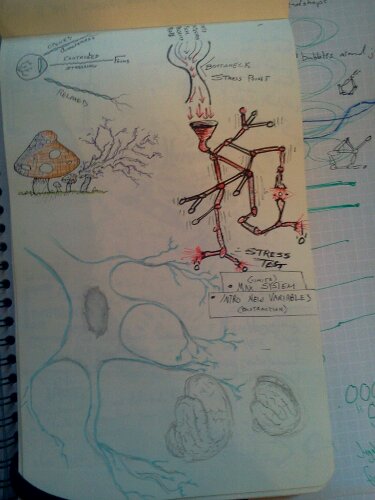
Some miscellaneous stuff jumbled together with my project brain-storming notes (pun intended).

Some miscellaneous stuff jumbled together with my project brain-storming notes (pun intended).
In the documentary, When the Devil Knocks, Hilary is one of 6 personalities (referred to as “alters”). As stated at the beginning, the alters were created in order to help Hilary survive by taking over in times of trauma. A unique alter was created to deal with each unique traumatic situation. For example, a young boy alter took control when it was necessary to befriend her abuser, who promised to teach her/him how to shoot a 12 gauge shotgun. A sad young girl alter was born to carry the burden of remembering and dealing with the actual events of abuse. The eldest 15 year old girl alter, Mary, came into power as a source of strength and/or control.
Though the film only showcases 5 of the alters, there were 35 that Hilary had to share her life with. Apparently there were many abusers throughout her life, which only fragmented her life even more.
 I had shown up to the theater about 8 minutes late, though they had some problems with the projector, thus forcing them to restart the film from the start (lucky me!). The only seats available were in the very front left of the theater. After the film had finished, I noticed everyone standing, turning and applauding. The film maker, Hilary, her life partner and therapist were in attendance! They set up the mic stand just in front of me (I had to move my bag so they had enough room).
I had shown up to the theater about 8 minutes late, though they had some problems with the projector, thus forcing them to restart the film from the start (lucky me!). The only seats available were in the very front left of the theater. After the film had finished, I noticed everyone standing, turning and applauding. The film maker, Hilary, her life partner and therapist were in attendance! They set up the mic stand just in front of me (I had to move my bag so they had enough room).
Many interesting questions were asked, all of which were very different from the typical Q&A I am used to hearing.
In the film, I had noticed that whenever Hilary let one of her alters take over, they would usually knock or carefully take off her glasses. During the Q&A, I had asked, “Typically we are used to seeing characters in films take off their glasses as they took on different personalities. This, we usually assume, is for dramatic effect. However, in your case, why did the different alters take off your glasses? Did each personality have it’s own prescription?.” Hilary replied, “Yes, all my personalities had different prescriptions. Some were very uncomfortable with glasses altogether, and other alters had requested specific prescriptions that were different from my own.” I had asked if they had ever done any actual in-office testing and she said that they had actually intended to, but never got around to it. This provides me with more evidence showing that the mind is a larger factor on the eyes than we realize.
I found this very interesting, as I’ve read about cases where traumatic events would cause problems for the eyes, but only at a distance that is similar to the one when the original traumatic event was experienced. For example, there was a story of a woman who witnessed the death of a loved one at 10 feet. She could see closer than 10 feet, and further than 10 feet, but she could not focus on objects at exactly 10 feet.
I would have also liked to have queried more into other physical attributes, such as back or neck pain, as a friend of mine brought these types of symptoms to my attention. For example, a message that releases physical tension also releases or reveals emotional stress.
I felt the documentary was interesting, especially in how it made me look inward on how I deal with stressful situations. Though it’s difficult to say that I understand what she went through, a small piece of me can relate to the way the mind deals with trauma.
© 2025 Jer's Life
Theme by Anders Noren — Up ↑